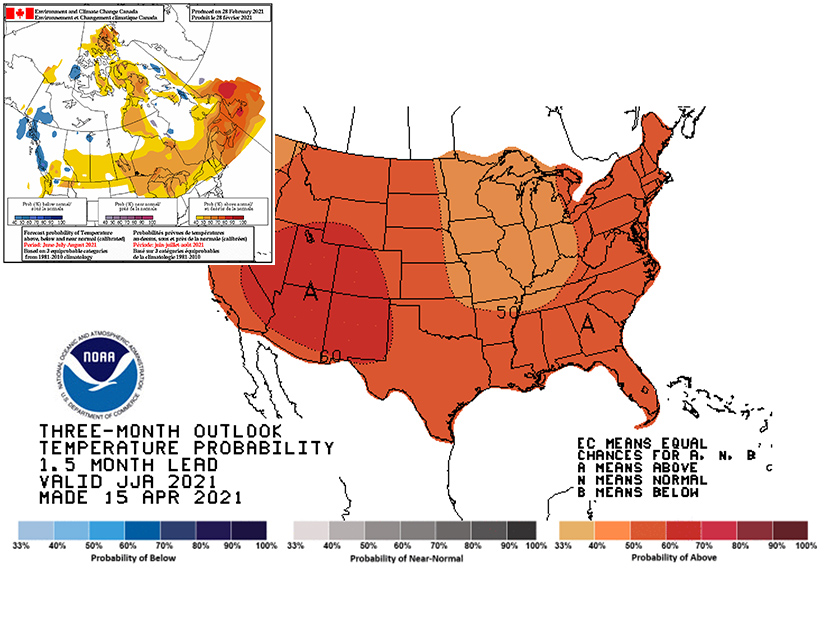Summer 2021 “is shaping up to be a challenge for electric system operators” in most of the ERO Enterprise thanks to extreme weather and elevated temperatures, NERC said in its 2021 Summer Reliability Assessment released Wednesday.
Although resource availability has improved since last year, with all regions possessing sufficient anticipated reserve margins that exceed their reference margin levels, ERCOT, WECC, MISO and NPCC are still at elevated risk of energy emergencies due to above-normal temperatures predicted across much of North America that can push demand higher while also affecting availability of generation resources.
California is in particular danger, with energy emergencies possible even during periods of normal peak demand and more likely “when above-normal demand is widespread in the West,” echoing WECC’s warnings from earlier this year. (See Southern Calif. Could Fail RA Test, WECC Says.)
The California-Mexico (CAMX) assessment area faces the greatest risk, despite planned resource additions of 1,300 MW over the summer, because of the widespread use of solar facilities in the region. NERC predicts more than 10,000 MWh of expected unserved energy in CAMX for the upcoming summer.
While solar resources are capable of meeting daily peak demand, problems arise later in the day as output diminishes and demand remains high due to continued warm temperatures. While California’s current 625 MW of battery storage — and a further 875 MW scheduled to be installed this summer — will help alleviate the problem, energy imports and thermal resources will still be needed to make up the shortfall. If either is not available, firm load shedding and forced outages may be necessary to maintain stability.
Wildfires are also a major factor again this year due to the heat and dry conditions expected in late summer across the Western U.S. and Canada, as FERC Summer Assessment Spotlights Western Drought Risks.) Western utilities may have to initiate public safety power shutoffs to mitigate the risk of wildfires, potentially impacting thousands of customers.
Texas Faces Resource Shortfalls
Energy emergencies remain a high risk for Texas as well. While the state looks good on paper, with the 15.3% planning reserve margin comfortably above its 13.75% reference margin level thanks to the addition of more than 7.8GW of generation resources since last year, it is expected to face many of the issues that are worrying WECC.
For one thing, many of the resources added since 2020 are wind and solar facilities, bringing the same concerns about their dependence on weather. In Texas the biggest question is around wind, which accounts for a “significant portion” of electricity supply in the state. As a result, grid operators must have plans for what to do in periods of low wind.
Wind availability is concerning enough to merit two scenarios exploring the implications of weather-related shortfalls in the assessment. In one, the organization combined a 50/50 peak demand forecast, which has a 50% chance of being exceeded, with a prediction of 90/10 low wind conditions, which has a 10% chance of being exceeded. Under this scenario, assuming operational mitigations of 2.3 GW, expected operating reserves fell to just 1 GW, a worryingly thin margin.
The other scenario combined a one-in-10-year forecast for demand levels with extremely low resources, with 12.1% of expected thermal resources unavailable and wind output reduced by 76.8%. This resulted in a 12.7 GW shortfall. Though the report acknowledges this combination of high demand and low resource availability is “exceedingly rare,” it does call the scenario a “plausible” depiction that provides “insights into potential emergency conditions.”
COVID-19 Continues to Complicate Forecasts
All other regions are expected to have little trouble meeting peak demand, though the report warns that MISO and NPCC-New England could see demand exceeding capacity resources in the 90/10 forecast, requiring “additional non-firm transfers from surrounding areas.” Predicting demand is also likely to be once again more difficult this year than usual due to the ongoing impacts of the COVID-19 pandemic, especially with many employers ending their remote work postures. The impact of the return to normal is likely to affect commercial and residential loads in ways that are hard to predict.
Despite the progress of vaccinations, NERC predicts that pandemic-related health measures will also be needed throughout the summer, especially as utilities undertake customary mutual assistance efforts during the upcoming hurricane season.
Although utilities have by now largely gotten used to these protocols, they remain a complicating factor in planning. For example, social distancing and personal protective equipment were featured prominently in SERC Reliability’s spring extreme weather webinar last week. (See SERC Urges Preparation Ahead of 2021 Hurricane Season.)






